
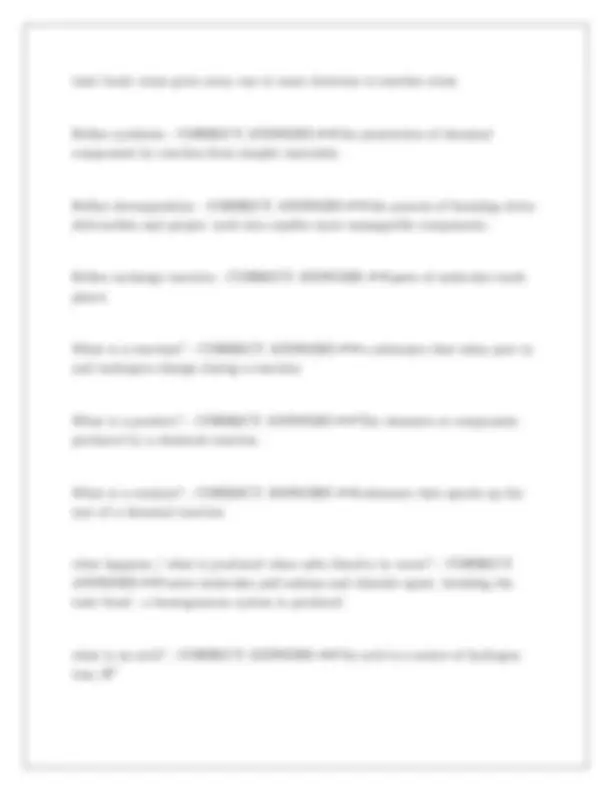
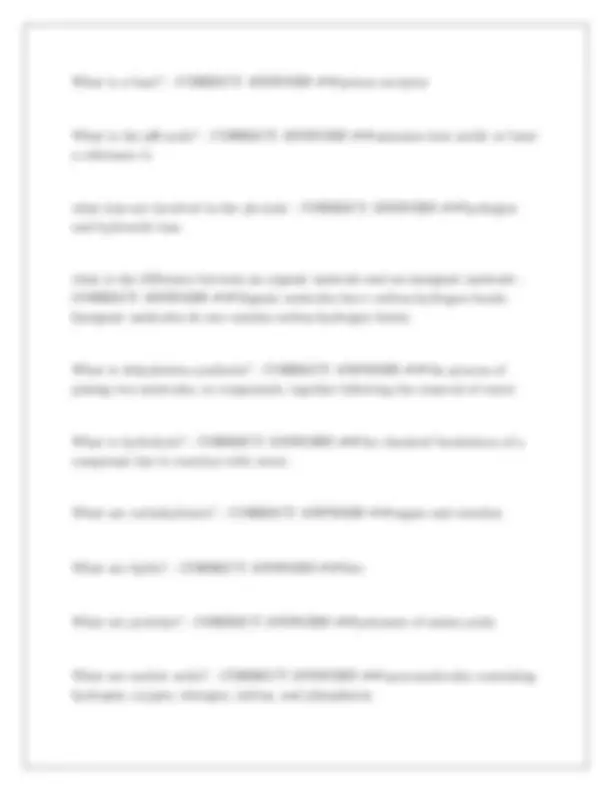
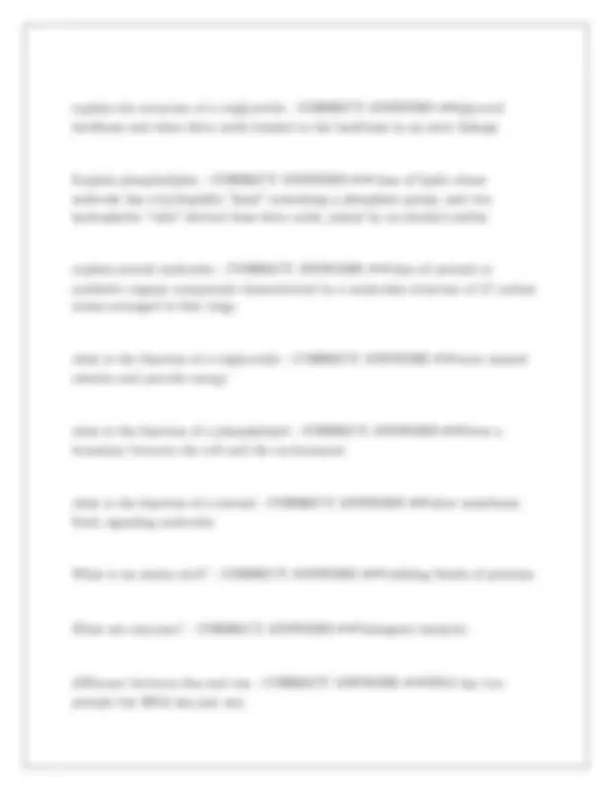
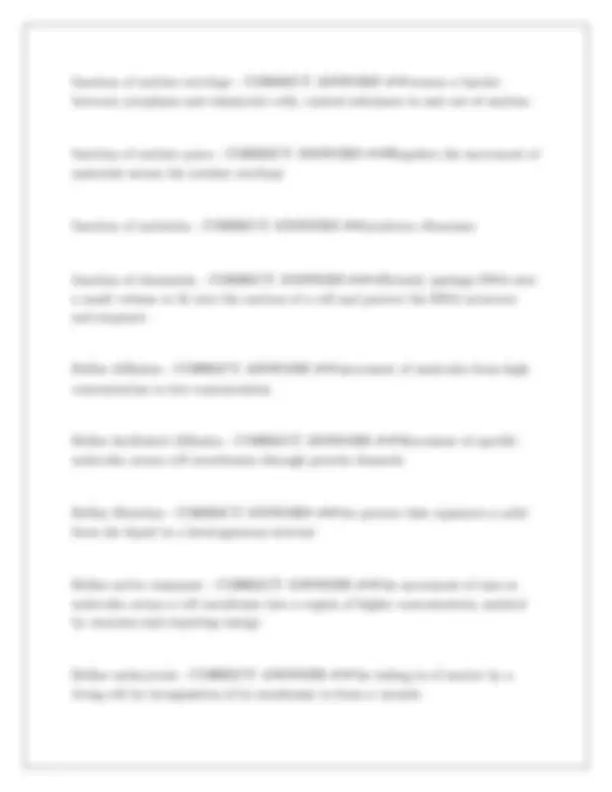
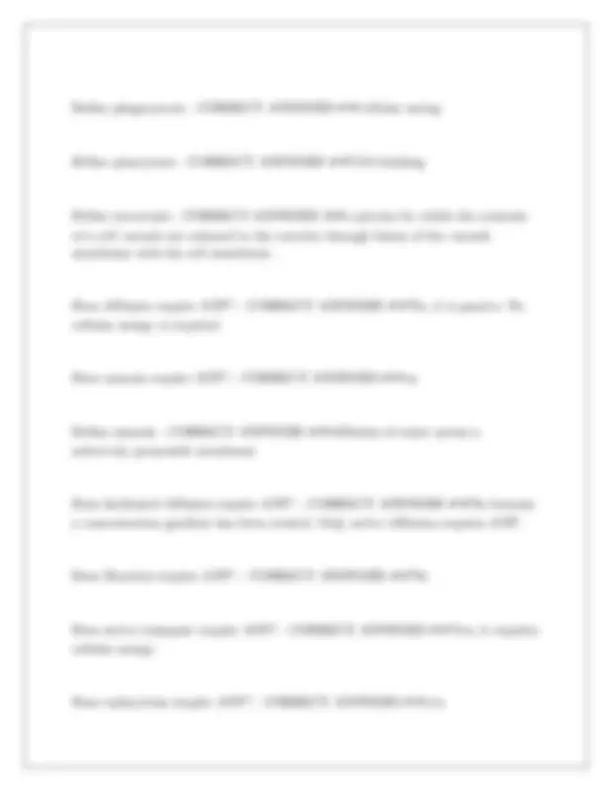
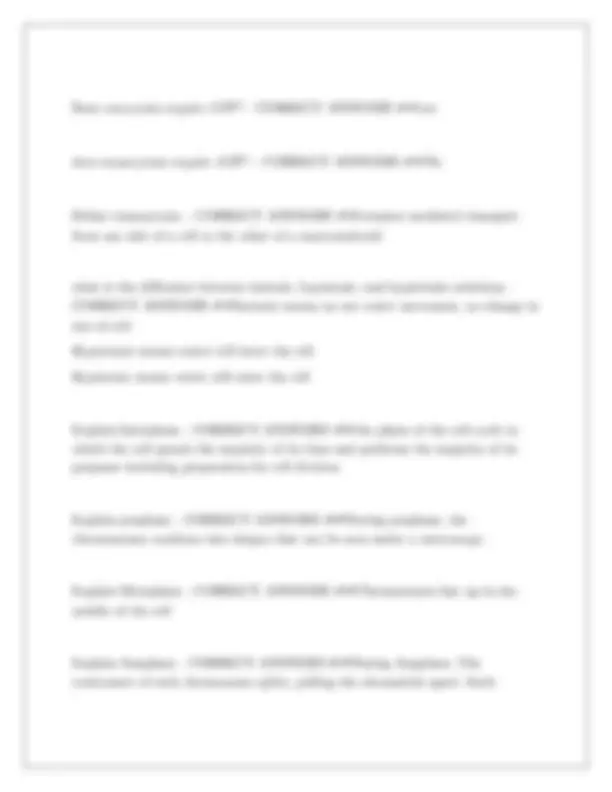
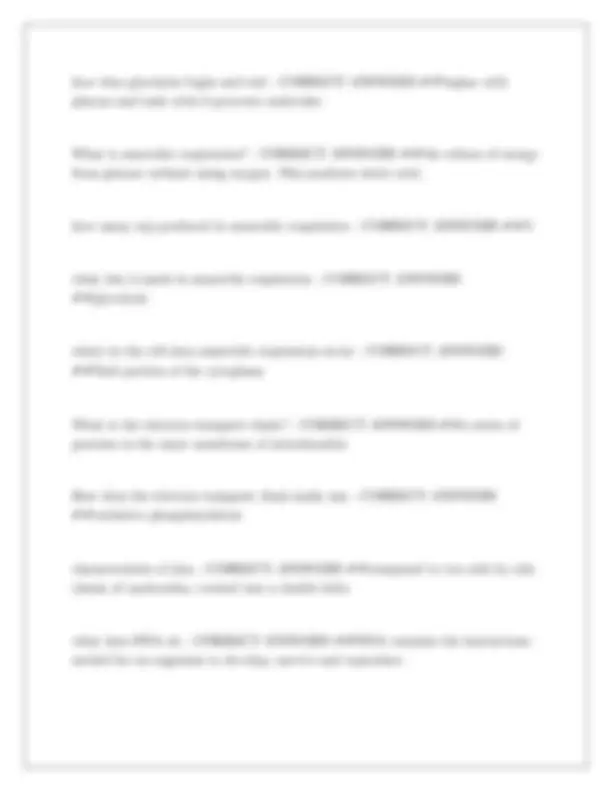
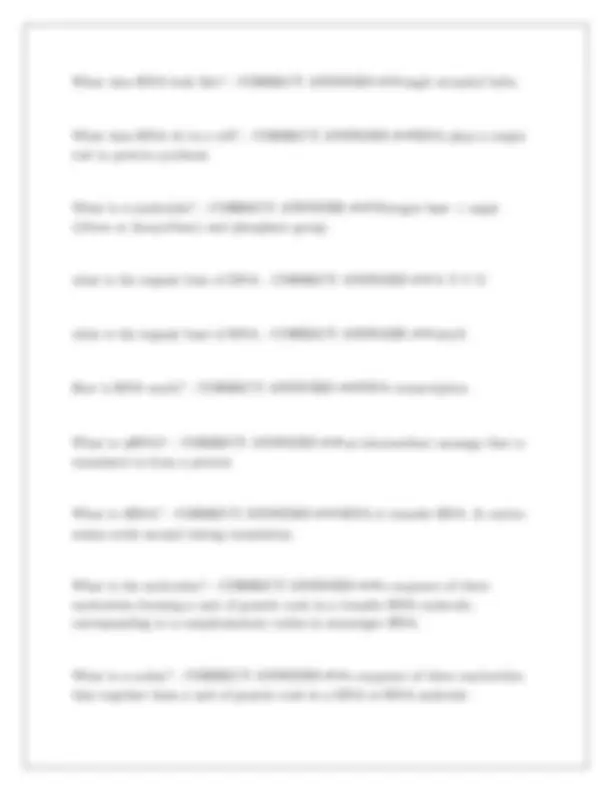
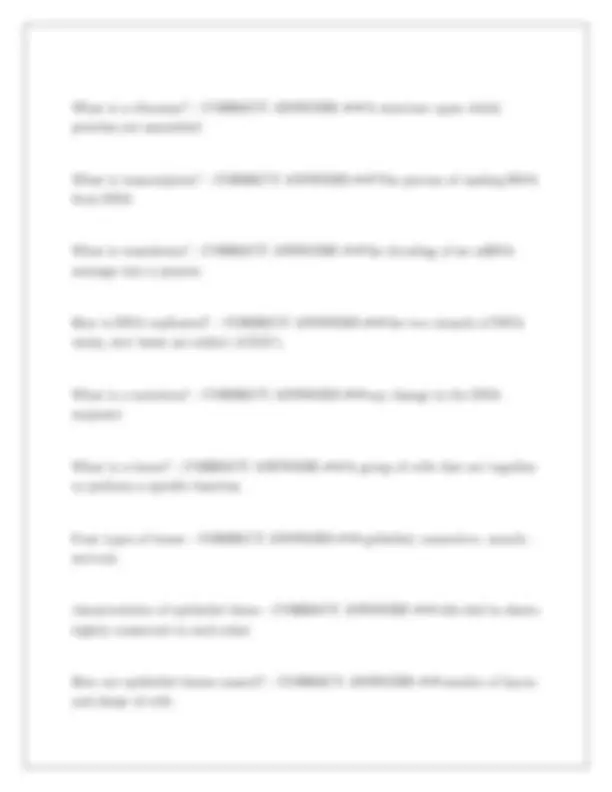

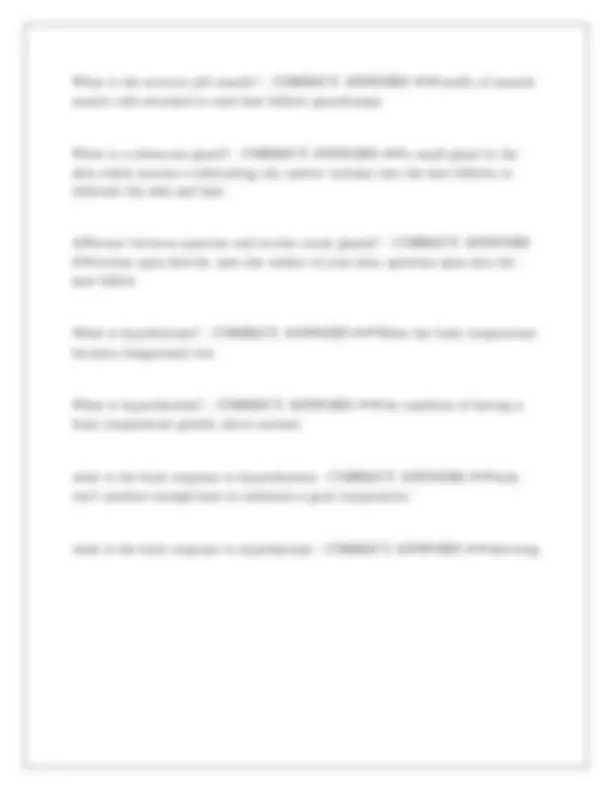


Study with the several resources on Docsity

Earn points by helping other students or get them with a premium plan


Prepare for your exams
Study with the several resources on Docsity

Earn points to download
Earn points by helping other students or get them with a premium plan
Community
Ask the community for help and clear up your study doubts
Discover the best universities in your country according to Docsity users
Free resources
Download our free guides on studying techniques, anxiety management strategies, and thesis advice from Docsity tutors
A comprehensive review of key concepts in aphy 101, covering topics such as the levels of organization, characteristics of life, requirements of life, homeostasis, matter, elements, atoms, chemical bonding, organic and inorganic molecules, carbohydrates, lipids, proteins, nucleic acids, cell structure and function, and transport mechanisms. It includes multiple-choice questions with answers, making it a valuable resource for students preparing for their midterm exam.
Typology: Exams
1 / 19

This page cannot be seen from the preview
Don't miss anything!












What is the difference between anatomy and physiology? - CORRECT ANSWERS ✔✔anatomy is study of body structure and physiology is study of how those structures work What are the levels of organization and define each - CORRECT ANSWERS ✔✔organelle: cell structure that carries out special function in the cell cell: basic unit of structure & function in a living thing tissue: a group of similar cells that are organized to do a specific job organ: a collection of tissues that carry out a specialized function of the body organ system: group of organs that work together to perform a specific function organism: a living thing made of a group of organ systems What are the characteristics of life and define each - CORRECT ANSWERS ✔✔Responsiveness to the environment, growth and change, ability to reproduce, have a metabolism and breathe, maintain homeostasis, being made of cells, passing traits to offspring what are the requirements of life? why is each important? - CORRECT ANSWERS ✔✔water: needed to transport substances to regulate the body food: needed to supply energy and for regulation oxygen: needed to help release energy from food substances heat: needed to regulate the rate of metabolic processes pressure: needed for breathing and circulation
Define homeostasis - CORRECT ANSWERS ✔✔Maintaining a stable internal environment what is a homeostatic mechanism - CORRECT ANSWERS ✔✔tendency to maintain relatively constant conditions in the environment Define matter, element and atom. What is the basic unit of matter? - CORRECT ANSWERS ✔✔matter: any substance that has mass and takes up space atom: smallest unit of ordinary matter basic unit of matter: atoms what is the structure of an atom - CORRECT ANSWERS ✔✔protons, neutrons, electrons define nucleus, proton, neutron, and electron. What charges do each of these particles have? - CORRECT ANSWERS ✔✔nucleus: central core of an atom, positive proton: stable subatomic particle, positive neutron: subatomic particle, no charge electron: stable subatomic particle, negative what are covalent, ionic and hydrogen bonds and what are the differences between the three? - CORRECT ANSWERS ✔✔covalent: 2 atoms shared 1 or more molecules hydrogen: weak bond between 2 opposite positively charged sides of 2 or more molecules
What is a base? - CORRECT ANSWERS ✔✔proton acceptor What is the pH scale? - CORRECT ANSWERS ✔✔measures how acidic or basic a substance is what ions are involved in the ph scale - CORRECT ANSWERS ✔✔hydrogen and hydroxide ions what is the difference between an organic molecule and an inorganic molecule - CORRECT ANSWERS ✔✔Organic molecules have carbon-hydrogen bonds. Inorganic molecules do not contain carbon-hydrogen bonds. What is dehydration synthesis? - CORRECT ANSWERS ✔✔the process of joining two molecules, or compounds, together following the removal of water What is hydrolysis? - CORRECT ANSWERS ✔✔the chemical breakdown of a compound due to reaction with water. What are carbohydrates? - CORRECT ANSWERS ✔✔sugars and starches What are lipids? - CORRECT ANSWERS ✔✔fats What are proteins? - CORRECT ANSWERS ✔✔polymers of amino acids What are nucleic acids? - CORRECT ANSWERS ✔✔macromolecules containing hydrogen, oxygen, nitrogen, carbon, and phosphorus
explain the structure of a triglyceride - CORRECT ANSWERS ✔✔glycerol backbone and three fatty acids bonded to the backbone in an ester linkage Explain phospholipids - CORRECT ANSWERS ✔✔class of lipids whose molecule has a hydrophilic "head" containing a phosphate group, and two hydrophobic "tails" derived from fatty acids, joined by an alcohol residue explain steroid molecules - CORRECT ANSWERS ✔✔class of natural or synthetic organic compounds characterized by a molecular structure of 17 carbon atoms arranged in four rings. what is the function of a triglyceride - CORRECT ANSWERS ✔✔store unused calories and provide energy what is the function of a phospholipid - CORRECT ANSWERS ✔✔form a boundary between the cell and the environment what is the function of a steroid - CORRECT ANSWERS ✔✔alter membrane fluid, signaling molecules What is an amino acid? - CORRECT ANSWERS ✔✔building blocks of proteins What are enzymes? - CORRECT ANSWERS ✔✔biological catalysts difference between dna and rna - CORRECT ANSWERS ✔✔DNA has two strands but RNA has just one
primary function of rough er - CORRECT ANSWERS ✔✔produce proteins for rest of cell to function primary function of golgi apparatus - CORRECT ANSWERS ✔✔packaging proteins and lipids into vesicles for delivery primary function of mitochondria - CORRECT ANSWERS ✔✔generate energy needed to power the cells biochemical reactions primary function of lysosome - CORRECT ANSWERS ✔✔break down excess or worn out cell parts primary function of peroxisome - CORRECT ANSWERS ✔✔oxidize certain molecules normally found in the cell primary function of centrosomes - CORRECT ANSWERS ✔✔duplicates and then helps with cell division primary function of cilla - CORRECT ANSWERS ✔✔moves water relative to the cell in a regular movement of cilla primary function of flagella - CORRECT ANSWERS ✔✔functions as a sensory organelle being sensitive to chemicals and temperatures outside the cell main function of vesicle - CORRECT ANSWERS ✔✔help move proteins and molecules from one part of the cell to another
function of nuclear envelope - CORRECT ANSWERS ✔✔creates a barrier between cytoplasm and eukaryotic cells. control substance in and out of nucleus function of nuclear pores - CORRECT ANSWERS ✔✔Regulate the movement of materials across the nuclear envelope function of nucleolus - CORRECT ANSWERS ✔✔produces ribosomes function of chromatin - CORRECT ANSWERS ✔✔efficiently package DNA into a small volume to fit into the nucleus of a cell and protect the DNA structure and sequence Define diffusion - CORRECT ANSWERS ✔✔movement of molecules from high concentration to low concentration Define facilitated diffusion - CORRECT ANSWERS ✔✔Movement of specific molecules across cell membranes through protein channels Define filtration - CORRECT ANSWERS ✔✔the process that separates a solid from the liquid in a heterogeneous mixture Define active transport - CORRECT ANSWERS ✔✔the movement of ions or molecules across a cell membrane into a region of higher concentration, assisted by enzymes and requiring energy. Define endocytosis - CORRECT ANSWERS ✔✔the taking in of matter by a living cell by invagination of its membrane to form a vacuole.
Does exocytosis require ATP? - CORRECT ANSWERS ✔✔yes does transcytosis require ATP? - CORRECT ANSWERS ✔✔No Define transcytosis. - CORRECT ANSWERS ✔✔receptor mediated transport from one side of a cell to the other of a macromolecule what is the difference between isotonic, hypotonic, and hypertonic solutions - CORRECT ANSWERS ✔✔Isotonic means no net water movement, no change in size of cell Hypertonic means water will leave the cell Hypotonic means water will enter the cell Explain Interphase - CORRECT ANSWERS ✔✔the phase of the cell cycle in which the cell spends the majority of its time and performs the majority of its purposes including preparation for cell division Explain prophase - CORRECT ANSWERS ✔✔During prophase, the chromosomes condense into shapes that can be seen under a microscope. Explain Metaphase - CORRECT ANSWERS ✔✔Chromosomes line up in the middle of the cell Explain Anaphase - CORRECT ANSWERS ✔✔During Anaphase, The centromere of each chromosome splits, pulling the chromatids apart. Each
chromatid is now called a chromosome. These chromosomes are drawn by their spindle fibers to opposite ends of the cell. Explain Telophase - CORRECT ANSWERS ✔✔The chromosomes move to opposite ends of the cell and begin to unwind their spindle fibers. After that, A nuclear envelope forms around each set of chromosomes, the nucleoli reform and ribosomes are assembled. As the nucleoli forms, the cell's cytoplasm begins to divide. Explain cytokinesis - CORRECT ANSWERS ✔✔Cytoplasm divides and two nuclei are segregated into separate daughter cells What is anabolism? - CORRECT ANSWERS ✔✔building up What is catabolism? - CORRECT ANSWERS ✔✔breaking down What is an enzyme? - CORRECT ANSWERS ✔✔a substance produced by a living organism that acts as a catalyst to bring about a specific biochemical reaction. How does an enzyme convert a substrate to a product? - CORRECT ANSWERS ✔✔enzyme will bind to one or more molecules what is the active site on an enzyme - CORRECT ANSWERS ✔✔the part where the substrate binds define denaturization - CORRECT ANSWERS ✔✔modification of the structure of a protein
how does glycolysis begin and end - CORRECT ANSWERS ✔✔begins with glucose and ends with 2 pyruvate molecules What is anaerobic respiration? - CORRECT ANSWERS ✔✔the release of energy from glucose without using oxygen. This produces lactic acid. how many atp produced in anaerobic respiration - CORRECT ANSWERS ✔✔ 2 what else is made in anaerobic respiration - CORRECT ANSWERS ✔✔glycolysis where in the cell does anaerobic respiration occur - CORRECT ANSWERS ✔✔fluid portion of the cytoplasm What is the electron transport chain? - CORRECT ANSWERS ✔✔a series of proteins in the inner membrane of mitochondria How does the electron transport chain make atp - CORRECT ANSWERS ✔✔oxidative phosphorylation characteristics of dna - CORRECT ANSWERS ✔✔composed to two side by side chains of nucleotides, twisted into a double helix what does DNA do - CORRECT ANSWERS ✔✔DNA contains the instructions needed for an organism to develop, survive and reproduce.
What does RNA look like? - CORRECT ANSWERS ✔✔single stranded helix What does RNA do in a cell? - CORRECT ANSWERS ✔✔RNA plays a major role in protein synthesis What is a nucleotide? - CORRECT ANSWERS ✔✔Nitrogen base + sugar (ribose or deoxyribose) and phosphate group what is the organic base of DNA - CORRECT ANSWERS ✔✔A T C G what is the organic base of RNA - CORRECT ANSWERS ✔✔uracil How is RNA made? - CORRECT ANSWERS ✔✔DNA transcription What is mRNA? - CORRECT ANSWERS ✔✔an intermediate message that is translated to form a protein What is tRNA? - CORRECT ANSWERS ✔✔tRNA is transfer RNA. It carries amino acids around during translation. What is the anticodon? - CORRECT ANSWERS ✔✔a sequence of three nucleotides forming a unit of genetic code in a transfer RNA molecule, corresponding to a complementary codon in messenger RNA. What is a codon? - CORRECT ANSWERS ✔✔a sequence of three nucleotides that together form a unit of genetic code in a DNA or RNA molecule.
where do you find each of the main epithelial tissues - CORRECT ANSWERS ✔✔line outer surfaces of organs and blood vessels and inner surfaces of cavities and internal organs define glandular epithelium - CORRECT ANSWERS ✔✔specialized epithelial cells that secret bodily products general characteristics of connective tissue? - CORRECT ANSWERS ✔✔composed of nonliving extracellular matrix that separates the cells of the tissue present in between tissues and around organs. general characteristics of cell types - CORRECT ANSWERS ✔✔cell membrane, organelle, cytoplasm, dna characteristics of fiber types - CORRECT ANSWERS ✔✔absorbing, comes in various shapes and sizes What is the matrix? - CORRECT ANSWERS ✔✔innermost compartment of the mitochondria characteristics of cartilige - CORRECT ANSWERS ✔✔thin avascular, flexible and resistant to compressive forces Define chondrocytes - CORRECT ANSWERS ✔✔mature cartilage cells
Define lacunae - CORRECT ANSWERS ✔✔small cavities that contain osteocytes Define osteocytes - CORRECT ANSWERS ✔✔A mature bone cell; an osteoblast that has become embedded within the bone matrix and occupies a lacuna. define lamealle - CORRECT ANSWERS ✔✔a thin layer, membrane, or plate of tissue, especially in bone Define canaliculi - CORRECT ANSWERS ✔✔Hairlike canals that connect lacunae to each other and the central canal Three types of muscle tissue - CORRECT ANSWERS ✔✔skeletal, cardiac, smooth characteristics of skeletal tissue - CORRECT ANSWERS ✔✔coordinates, regulates & integrates body functions, striated & voluntary, muscle attached to bones characteristics of cardiac tissue - CORRECT ANSWERS ✔✔involuntary and intrinsically controlled, striated, branched characteristics of smooth tissue - CORRECT ANSWERS ✔✔involuntarily controlled, not stirated, not branched, and singly nucleated What is a neuron? - CORRECT ANSWERS ✔✔a nerve cell; the basic building block of the nervous system
What is the arrector pili muscle? - CORRECT ANSWERS ✔✔bundle of smooth muscle cells attached to each hair follicle; goosebumps What is a sebaceous gland? - CORRECT ANSWERS ✔✔a small gland in the skin which secretes a lubricating oily matter (sebum) into the hair follicles to lubricate the skin and hair. difference between apocrine and eccrine sweat glands? - CORRECT ANSWERS ✔✔eccrine open directly onto the surface of your skin, apocrine open into the hair follicle What is hypothermia? - CORRECT ANSWERS ✔✔When the body temperature becomes dangerously low What is hyperthermia? - CORRECT ANSWERS ✔✔the condition of having a body temperature greatly above normal. what is the body response to hyperthermia - CORRECT ANSWERS ✔✔body can't produce enough heat to maintain a good temperature what is the body response to hypothermia - CORRECT ANSWERS ✔✔shivering